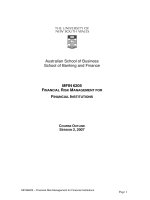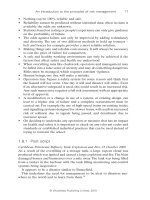Financial risk management models, history, and institution models, history, and institution
Bạn đang xem bản rút gọn của tài liệu. Xem và tải ngay bản đầy đủ của tài liệu tại đây (5.06 MB, 750 trang )
P1: a/b
P2: c/d
JWBT440-fm
QC: e/f
JWBT440-Malz
T1: g
August 21, 2011
11:53
Printer: To Come
P1: a/b
P2: c/d
JWBT440-fm
QC: e/f
T1: g
JWBT440-Malz
August 21, 2011
11:53
Printer: To Come
Financial Risk
Management
i
P1: a/b
P2: c/d
JWBT440-fm
QC: e/f
JWBT440-Malz
T1: g
August 21, 2011
11:53
Printer: To Come
Founded in 1807, John Wiley & Sons is the oldest independent publishing company in the United States. With offices in North America, Europe,
Australia, and Asia, Wiley is globally committed to developing and marketing print and electronic products and services for our customers’ professional
and personal knowledge and understanding.
The Wiley Finance series contains books written specifically for finance
and investment professionals as well as sophisticated individual investors
and their financial advisors. Book topics range from portfolio management
to e-commerce, risk management, financial engineering, valuation, and financial instrument analysis, as well as much more.
For a list of available titles, visit our Web site at www.WileyFinance.com.
ii
P1: a/b
P2: c/d
JWBT440-fm
QC: e/f
T1: g
JWBT440-Malz
August 21, 2011
11:53
Printer: To Come
Financial Risk
Management
Models, History, and Institutions
ALLAN M. MALZ
John Wiley & Sons, Inc.
iii
P1: a/b
P2: c/d
JWBT440-fm
QC: e/f
JWBT440-Malz
Copyright
C
T1: g
August 21, 2011
11:53
Printer: To Come
2011 by Allan M. Malz. All rights reserved.
Published by John Wiley & Sons, Inc., Hoboken, New Jersey.
Published simultaneously in Canada.
No part of this publication may be reproduced, stored in a retrieval system, or transmitted in
any form or by any means, electronic, mechanical, photocopying, recording, scanning, or
otherwise, except as permitted under Section 107 or 108 of the 1976 United States Copyright
Act, without either the prior written permission of the Publisher, or authorization through
payment of the appropriate per-copy fee to the Copyright Clearance Center, Inc., 222
Rosewood Drive, Danvers, MA 01923, (978) 750-8400, fax (978) 646-8600, or on the Web
at www.copyright.com. Requests to the Publisher for permission should be addressed to the
Permissions Department, John Wiley & Sons, Inc., 111 River Street, Hoboken, NJ 07030,
(201) 748-6011, fax (201) 748-6008, or online at www.wiley.com/go/permissions.
Limit of Liability/Disclaimer of Warranty: While the publisher and author have used their
best efforts in preparing this book, they make no representations or warranties with respect to
the accuracy or completeness of the contents of this book and specifically disclaim any implied
warranties of merchantability or fitness for a particular purpose. No warranty may be created
or extended by sales representatives or written sales materials. The advice and strategies
contained herein may not be suitable for your situation. You should consult with a
professional where appropriate. Neither the publisher nor author shall be liable for any loss of
profit or any other commercial damages, including but not limited to special, incidental,
consequential, or other damages.
For general information on our other products and services or for technical support, please
contact our Customer Care Department within the United States at (800) 762-2974, outside
the United States at (317) 572-3993 or fax (317) 572-4002.
Wiley also publishes its books in a variety of electronic formats. Some content that appears in
print may not be available in electronic books. For more information about Wiley products,
visit our Web site at www.wiley.com.
Library of Congress Cataloging-in-Publication Data:
Malz, Allan M.
Financial risk management: models, history, and institution : models, history, and
institution / Allan M. Malz.
p. cm. – (Wiley finance series)
Includes bibliographical references and index.
ISBN 978-0-470-48180-6 (cloth); ISBN 978-1-118-02291-7 (ebk);
ISBN 978-1-118-02290-0 (ebk); ISBN 978-1-118-02289-4 (ebk)
1. Financial risk management. I. Title.
HD61.M256 2011
332–dc22
2010043485
Printed in the United States of America
10 9 8 7 6 5 4 3 2 1
iv
P1: a/b
P2: c/d
JWBT440-fm
QC: e/f
JWBT440-Malz
T1: g
August 21, 2011
11:53
Printer: To Come
To
Karin, Aviva, and Benjamin
with love
v
P1: a/b
P2: c/d
JWBT440-fm
QC: e/f
JWBT440-Malz
T1: g
August 21, 2011
vi
11:53
Printer: To Come
P1: a/b
P2: c/d
JWBT440-fm
QC: e/f
JWBT440-Malz
T1: g
August 22, 2011
9:45
Printer: To Come
Contents
List of Figures
xvii
Preface
xxi
CHAPTER 1
Financial Risk in a Crisis-Prone World
1.1 Some History: Why Is Risk a Separate Discipline Today?
1.1.1 The Financial Industry Since the 1960s
1.1.2 The “Shadow Banking System”
1.1.3 Changes in Public Policy Toward the
Financial System
1.1.4 The Rise of Large Capital Pools
1.1.5 Macroeconomic Developments Since the
1960s: From the Unraveling of Bretton
Woods to the Great Moderation
1.2 The Scope of Financial Risk
1.2.1 Risk Management in Other Fields
Further Reading
CHAPTER 2
Market Risk Basics
2.1 Arithmetic, Geometric, and Logarithmic Security Returns
2.2 Risk and Securities Prices: The Standard Asset
Pricing Model
2.2.1 Defining Risk: States, Security Payoffs, and
Preferences
2.2.2 Optimal Portfolio Selection
2.2.3 Equilibrium Asset Prices and Returns
2.2.4 Risk-Neutral Probabilities
1
1
2
9
15
17
20
34
34
41
43
44
49
50
54
56
61
vii
P1: a/b
P2: c/d
JWBT440-fm
QC: e/f
JWBT440-Malz
T1: g
August 22, 2011
9:45
Printer: To Come
viii
CONTENTS
2.3
The Standard Asset Distribution Model
2.3.1 Random Walks and Wiener Processes
2.3.2 Geometric Brownian Motion
2.3.3 Asset Return Volatility
2.4 Portfolio Risk in the Standard Model
2.4.1 Beta and Market Risk
2.4.2 Diversification
2.4.3 Efficiency
2.5 Benchmark Interest Rates
Further Reading
CHAPTER 3
Value-at-Risk
3.1
3.2
3.3
3.4
3.5
Definition of Value-at-Risk
3.1.1 The User-Defined Parameters
3.1.2 Steps in Computing VaR
Volatility Estimation
3.2.1 Short-Term Conditional Volatility Estimation
3.2.2 The EWMA Model
3.2.3 The GARCH Model
Modes of Computation
3.3.1 Parametric
3.3.2 Monte Carlo Simulation
3.3.3 Historical Simulation
Short Positions
Expected Shortfall
Further Reading
CHAPTER 4
Nonlinear Risks and the Treatment of Bonds and Options
4.1
Nonlinear Risk Measurement and Options
4.1.1 Nonlinearity and VaR
4.1.2 Simulation for Nonlinear Exposures
4.1.3 Delta-Gamma for Options
4.1.4 The Delta-Gamma Approach for General
Exposures
4.2 Yield Curve Risk
4.2.1 The Term Structure of Interest Rates
4.2.2 Estimating Yield Curves
4.2.3 Coupon Bonds
63
64
71
74
75
76
82
85
88
91
93
94
97
98
99
99
104
106
108
108
109
111
113
114
116
119
121
123
126
127
134
136
138
141
144
P1: a/b
P2: c/d
JWBT440-fm
QC: e/f
JWBT440-Malz
T1: g
August 22, 2011
9:45
Printer: To Come
Contents
4.3 VaR for Default-Free Fixed Income Securities Using
The Duration and Convexity Mapping
4.3.1 Duration
4.3.2 Interest-Rate Volatility and Bond Price Volatility
4.3.3 Duration-Only VaR
4.3.4 Convexity
4.3.5 VaR Using Duration and Convexity
Further Reading
CHAPTER 5
Portfolio VaR for Market Risk
5.1 The Covariance and Correlation Matrices
5.2 Mapping and Treatment of Bonds and Options
5.3 Delta-Normal VaR
5.3.1 The Delta-Normal Approach for a Single
Position Exposed to a Single Risk Factor
5.3.2 The Delta-Normal Approach for a Single
Position Exposed to Several Risk Factors
5.3.3 The Delta-Normal Approach for a Portfolio
of Securities
5.4 Portfolio VAR via Monte Carlo simulation
5.5 Option Vega Risk
5.5.1 Vega Risk and the Black-Scholes Anomalies
5.5.2 The Option Implied Volatility Surface
5.5.3 Measuring Vega Risk
Further Reading
CHAPTER 6
Credit and Counterparty Risk
6.1 Defining Credit Risk
6.2 Credit-Risky Securities
6.2.1 The Economic Balance Sheet of the Firm
6.2.2 Capital Structure
6.2.3 Security, Collateral, and Priority
6.2.4 Credit Derivatives
6.3 Transaction Cost Problems in Credit Contracts
6.4 Default and Recovery: Analytic Concepts
6.4.1 Default
6.4.2 Probability of Default
6.4.3 Credit Exposure
ix
148
149
150
152
154
155
156
159
160
162
163
164
166
168
174
175
176
180
183
190
191
192
193
193
194
195
196
196
199
199
200
201
P1: a/b
P2: c/d
JWBT440-fm
QC: e/f
JWBT440-Malz
T1: g
August 22, 2011
9:45
Printer: To Come
x
CONTENTS
6.5
6.6
6.7
6.8
6.9
6.4.4 Loss Given Default
6.4.5 Expected Loss
6.4.6 Credit Risk and Market Risk
Assessing creditworthiness
6.5.1 Credit Ratings and Rating Migration
6.5.2 Internal Ratings
6.5.3 Credit Risk Models
Counterparty Risk
6.6.1 Netting and Clearinghouses
6.6.2 Measuring Counterparty Risk for Derivatives
Positions
6.6.3 Double Default Risk
6.6.4 Custodial Risk
6.6.5 Mitigation of Counterparty Risk
The Merton model
Credit Factor Models
Credit Risk Measures
6.9.1 Expected and Unexpected Loss
6.9.2 Jump-to-Default Risk
Further Reading
CHAPTER 7
Spread Risk and Default Intensity Models
7.1
Credit Spreads
7.1.1 Spread Mark-to-Market
7.2 Default Curve Analytics
7.2.1 The Hazard Rate
7.2.2 Default Time Distribution Function
7.2.3 Default Time Density Function
7.2.4 Conditional Default Probability
7.3 Risk-Neutral Estimates of Default Probabilities
7.3.1 Basic Analytics of Risk-Neutral Default Rates
7.3.2 Time Scaling of Default Probabilities
7.3.3 Credit Default Swaps
7.3.4 Building Default Probability Curves
7.3.5 The Slope of Default Probability Curves
7.4 Spread Risk
7.4.1 Mark-to-Market of a CDS
7.4.2 Spread Volatility
Further Reading
201
202
204
204
204
207
207
207
209
209
211
211
212
213
222
226
228
229
229
231
231
233
235
237
239
239
240
241
242
245
246
250
259
261
261
262
264
P1: a/b
P2: c/d
JWBT440-fm
QC: e/f
T1: g
JWBT440-Malz
August 22, 2011
9:45
Printer: To Come
Contents
CHAPTER 8
Portfolio Credit Risk
8.1 Default Correlation
8.1.1 Defining Default Correlation
8.1.2 The Order of Magnitude of Default Correlation
8.2 Credit Portfolio Risk Measurement
8.2.1 Granularity and Portfolio Credit Value-at-Risk
8.3 Default Distributions and Credit VaR with the
Single-Factor Model
8.3.1 Conditional Default Distributions
8.3.2 Asset and Default Correlation
8.3.3 Credit VaR Using the Single-Factor Model
8.4 Using Simulation and Copulas to Estimate Portfolio
Credit Risk
8.4.1 Simulating Single-Credit Risk
8.4.2 Simulating Joint Defaults with a Copula
Further Reading
CHAPTER 9
Structured Credit Risk
9.1 Structured Credit Basics
9.1.1 Capital Structure and Credit Losses in a
Securitization
9.1.2 Waterfall
9.1.3 Issuance Process
9.2 Credit Scenario Analysis of a Securitization
9.2.1 Tracking the Interim Cash Flows
9.2.2 Tracking the Final-Year Cash Flows
9.3 Measuring Structured Credit Risk via Simulation
9.3.1 The Simulation Procedure and the Role of
Correlation
9.3.2 Means of the Distributions
9.3.3 Distribution of Losses and Credit VaR
9.3.4 Default Sensitivities of the Tranches
9.3.5 Summary of Tranche Risks
9.4 Standard Tranches and Implied Credit Correlation
9.4.1 Credit Index Default Swaps and Standard
Tranches
9.4.2 Implied Correlation
9.4.3 Summary of Default Correlation Concepts
xi
265
266
266
270
270
270
275
275
279
281
284
286
288
295
297
297
301
305
307
309
309
314
318
318
323
327
333
336
337
338
340
341
P1: a/b
P2: c/d
JWBT440-fm
QC: e/f
T1: g
JWBT440-Malz
August 22, 2011
9:45
Printer: To Come
xii
CONTENTS
9.5 Issuer and Investor Motivations for Structured Credit
9.5.1 Incentives of Issuers
9.5.2 Incentives of Investors
Further Reading
CHAPTER 10
Alternatives to the Standard Market Risk Model
10.1
10.2
10.3
Real-World Asset Price Behavior
Alternative Modeling Approaches
10.2.1 Jump-Diffusion Models
10.2.2 Extreme Value Theory
The Evidence on Non-Normality in Derivatives Prices
10.3.1 Option-Based Risk-Neutral Distributions
10.3.2 Risk-Neutral Asset Price Probability
Distributions
10.3.3 Implied Correlations
Further Reading
CHAPTER 11
Assessing the Quality of Risk Measures
11.1
11.2
11.3
Model Risk
11.1.1 Valuation Risk
11.1.2 Variability of VaR Estimates
11.1.3 Mapping Issues
11.1.4 Case Study: The 2005 Credit Correlation
Episode
11.1.5 Case Study: Subprime Default Models
Backtesting of VaR
Coherence of VaR Estimates
Further Reading
CHAPTER 12
Liquidity and Leverage
12.1
Funding Liquidity Risk
12.1.1 Maturity Transformation
12.1.2 Liquidity Transformation
12.1.3 Bank Liquidity
12.1.4 Structured Credit and Off-Balance-Sheet
Funding
12.1.5 Funding Liquidity of Other Intermediaries
12.1.6 Systematic Funding Liquidity Risk
342
343
345
346
349
349
363
363
365
372
372
380
387
390
393
393
395
395
397
399
405
407
414
419
421
422
422
423
425
429
432
434
P1: a/b
P2: c/d
JWBT440-fm
QC: e/f
JWBT440-Malz
T1: g
August 22, 2011
9:45
Printer: To Come
xiii
Contents
12.2
12.3
12.4
12.5
12.6
Markets for Collateral
12.2.1 Structure of Markets for Collateral
12.2.2 Economic Function of Markets for Collateral
12.2.3 Prime Brokerage and Hedge Funds
12.2.4 Risks in Markets for Collateral
Leverage and Forms of Credit in Contemporary Finance
12.3.1 Defining and Measuring Leverage
12.3.2 Margin Loans and Leverage
12.3.3 Short Positions
12.3.4 Derivatives
12.3.5 Structured Credit
12.3.6 Asset Volatility and Leverage
Transactions Liquidity Risk
12.4.1 Causes of Transactions Liquidity Risk
12.4.2 Characteristics of Market Liquidity
Liquidity Risk Measurement
12.5.1 Measuring Funding Liquidity Risk
12.5.2 Measuring Transactions Liquidity Risk
Liquidity and Systemic Risk
12.6.1 Funding Liquidity and Solvency
12.6.2 Funding and Market Liquidity
12.6.3 Systemic Risk and the “Plumbing”
12.6.4 “Interconnectedness”
Further Reading
CHAPTER 13
Risk Control and Mitigation
13.1
13.2
13.3
13.4
13.5
13.6
Defining Risk Capital
Risk Contributions
13.2.1 Risk Contributions in a Long-Only Portfolio
13.2.2 Risk Contributions Using Delta Equivalents
13.2.3 Risk Capital Measurement for
Quantitative Strategies
Stress Testing
13.3.1 An Example of Stress Testing
13.3.2 Types of Stress Tests
Sizing Positions
13.4.1 Diversification
13.4.2 Optimization and Implied Views
Risk Reporting
Hedging and Basis Risk
Further Reading
437
438
441
443
445
448
448
454
455
456
460
460
461
461
463
464
464
466
469
469
471
471
473
474
477
478
480
481
485
490
499
501
504
506
506
507
509
512
516
P1: a/b
P2: c/d
JWBT440-fm
QC: e/f
JWBT440-Malz
T1: g
August 22, 2011
9:45
Printer: To Come
xiv
CONTENTS
CHAPTER 14
Financial Crises
14.1
14.2
14.3
14.4
14.5
Panics, Runs, and Crashes
14.1.1 Monetary and Credit Contraction
14.1.2 Panics
14.1.3 Rising Insolvencies
14.1.4 Impairment of Market Functioning
Self-Reinforcing Mechanisms
14.2.1 Net Worth and Asset Price Declines
14.2.2 Collateral Devaluation
14.2.3 Risk Triggers
14.2.4 Accounting Triggers
Behavior of Asset Prices During Crises
14.3.1 Credit Spreads
14.3.2 Extreme Volatility
14.3.3 Correlations
Causes of Financial Crises
14.4.1 Debt, International Payments, and Crises
14.4.2 Interest Rates and Credit Expansion
14.4.3 Procyclicality: Financial Causes of Crises
14.4.4 Models of Bubbles and Crashes
Anticipating Financial Crises
14.5.1 Identifying Financial Fragility
14.5.2 Macroeconomic Predictors of Financial
Crises
14.5.3 Asset-Price Predictors of Financial
Crises
Further Reading
CHAPTER 15
Financial Regulation
15.1
15.2
15.3
Scope and Structure of Regulation
15.1.1 The Rationale of Regulation
15.1.2 Regulatory Authorities
Methods of Regulation
15.2.1 Deposit Insurance
15.2.2 Capital Standards
15.2.3 Bank Examinations and Resolution
Public Policy Toward Financial Crises
15.3.1 Financial Stability Policies
15.3.2 Lender of Last Resort
517
519
519
528
535
537
539
540
542
543
547
548
549
551
556
562
563
570
575
578
583
583
585
585
591
597
598
598
601
605
606
608
619
621
621
628
P1: a/b
P2: c/d
JWBT440-fm
QC: e/f
JWBT440-Malz
T1: g
August 22, 2011
9:45
Printer: To Come
xv
Contents
15.4
Pitfalls in Regulation
15.4.1 Moral Hazard and Risk Shifting
15.4.2 Regulatory Evasion
15.4.3 Unintended Consequences
Further Reading
APPENDIX A
Technical Notes
A.1 Binomial Distribution
A.2 Quantiles and Quantile Transformations
A.3 Normal and Lognormal Distributions
A.3.1 Relationship between Asset Price Levels
and Returns
A.3.2 The Black-Scholes Distribution Function
A.4 Hypothesis Testing
A.5 Monte Carlo Simulation
A.5.1 Fooled by Nonrandomness: Random
Variable Generation
A.5.2 Generating Nonuniform Random Variates
A.6 Homogeneous Functions
Further Reading
635
636
643
645
647
653
653
654
656
656
657
661
662
663
664
664
666
APPENDIX B
Abbreviations
667
APPENDIX C
References
671
Index
701
P1: a/b
P2: c/d
JWBT440-fm
QC: e/f
JWBT440-Malz
T1: g
August 22, 2011
xvi
9:45
Printer: To Come
P1: a/b
P2: c/d
JWBT440-fm
QC: e/f
JWBT440-Malz
T1: g
August 21, 2011
11:53
Printer: To Come
List of Figures
1.1
1.2
1.3
1.4
1.5
1.6
1.7
1.8
1.9
1.10
1.11
1.12
1.13
1.14
1.15
1.16
1.17
2.1
2.2
2.3
2.4
2.5
2.6
2.7
2.8
2.9
2.10
2.11
3.1
3.2
3.3
3.4
4.1
Disintermediation in the U.S. Financial System 1980–2010
Share of Financial Services Industry in U.S. Output
OTC Derivatives Markets 1998–2010
Intermediation by Sector 1959–2008
Traditional and Innovative Intermediation 1951–2010
Securitization of Commercial Real Estate Lending 1960–2010
Hedge Fund Assets under Management
Growth of World Income 1950–2006
Growth of World International Trade 1971–2009
U.S. Labor Productivity 1947–2010
U.S. Inflation 1958–2010
U.S. Current Account Balance 1960–2010
Growth of International Monetary Reserves
Real Fed Funds Rate 1971–2009
U.S. Growth Rate and Its Volatility 1947–2009
U.S. Savings Rate 1946–2010
Corporate Leverage in the United States
Approximating Logarithmic by Arithmetic Returns
Sample Path of a Random Walk
Convergence of a Random Walk to a Brownian Motion
Convergence of a Random Walk to a Brownian Motion
Geometric Brownian Motion: Asset Price Level
Geometric Brownian Motion: Daily Returns
Joint Distribution of EUR and JPY Returns
Correlation and Beta
Volatility and Beta
Diversification, Volatility, and Correlation
Minimum-Variance and Efficient Portfolios
Definition of VaR
The EWMA Weighting Scheme
Comparison of Volatility Estimators
Comparison of Simulation Approaches
Monotonicity and Option Risk Measurement
4
5
9
12
13
14
18
21
22
23
24
25
26
27
28
29
29
48
66
67
69
73
74
78
79
80
84
87
96
105
107
112
124
xvii
P1: a/b
P2: c/d
JWBT440-fm
xviii
4.2
4.3
4.4
4.5
4.6
4.7
4.8
5.1
5.2
5.3
5.4
5.5
5.6
5.7
5.8
6.1
6.2
6.3
6.4
6.5
7.1
7.2
7.3
7.4
7.5
7.6
7.7
7.8
8.1
8.2
8.3
8.4
8.5
8.6
8.7
8.8
8.9
8.10
8.11
9.1
QC: e/f
JWBT440-Malz
T1: g
August 21, 2011
11:53
Printer: To Come
LIST OF FIGURES
Delta-Gamma and VaR for an Unhedged Long Call
Delta-Gamma and VaR for a Hedged Call
Option Combinations
Delta-Gamma and Full-Repricing VaR for a Risk Reversal
Spot, Forward, and Discount Curves
Bond Price and Yield Volatility
Approximating the Bond Price-Yield Relationship
Time Variation of Implied Volatility
Option Vega
S&P 500 Implied Volatility Smile
EUR-USD Volatility Surface
Impact of Vega Risk
Euro Foreign Exchange Implied Volatilities
Vega and the Smile
Euro Implied Volatilities, Risk Reversals, and Strangle Prices
Default Rates 1920–2010
Merton Model
Asset and Market Index Returns in the Single-Factor Model
Distribution of Bond Value in the Merton Model
Credit VaR in the Merton Model
Computing Spread01 for a Fixed-Rate Bond
Spread01 a Declining Function of Spread Level
Intensity Model of Default Timing
CDS Curves
Estimation of Default Curves
Spread Curve Slope and Default Distribution
Morgan Stanley CDS Curves, select dates
Measuring Spread Volatility: Citigroup Spreads 2006–2010
Distribution of Defaults in an Uncorrelated Credit Portfolio
Distribution of Losses in an Uncorrelated Credit Portfolio
Default Probabilities in the Single-Factor Model
Single-Factor Default Probability Distribution
Conditional Default Density Function in the
Single-Factor Model
Distribution of Losses in the Single-Factor Model
Density Function of Portfolio Losses in the
Single-Factor Model
Estimated Single-Credit Default Risk by Simulation
Shifting from Uniform to Normal Distribution Simulations
Distribution of Losses in the Single-Factor Model
Simulating Multiple Defaults
Values of CLO Tranches
130
132
133
135
145
152
155
176
178
181
182
184
186
188
189
206
220
225
227
228
234
235
238
247
258
260
261
263
272
274
277
279
280
285
286
287
288
292
294
326
P1: a/b
P2: c/d
JWBT440-fm
QC: e/f
JWBT440-Malz
T1: g
August 21, 2011
11:53
Printer: To Come
List of Figures
9.2
9.3
9.4
9.5
10.1
10.2
10.3
10.4
10.5
10.6
10.7
10.8
10.9
10.10
10.11
10.12
10.13
10.14
11.1
11.2
11.3
11.4
11.5
11.6
11.7
11.8
11.9
12.1
12.2
12.3
12.4
13.1
13.2
13.3
13.4
14.1
14.2
14.3
14.4
14.5
14.6
Distribution of Simulated Equity Tranche Values
Distribution of Simulated Mezzanine Bond Tranche Losses
Distribution of Simulated Senior Bond Tranche Losses
Default Sensitivities of CLO Tranches
Normal and Non-Normal Distributions
S&P 500 Daily Returns 1928–2011
Statistical Properties of Exchange Rates
Kernel Estimate of the Distribution of VIX Returns
QQ Plot of USD Exchange Rates against the
Euro and Turkish Lira
Jump-Diffusion Process: Asset Price Level
Jump-Diffusion: Daily Returns
Elan Corporation Stock Price
QQ Plot of the S&P 500
Constructing a Long Butterfly
State Prices and the Risk Neutral Density
Fitted Implied Volatility Smile
Estimated Risk-Neutral Density
Risk-Neutral Implied Equity Correlation
Convexity of CLO Liabilities
Correlation Risk of the Convexity Trade
Implied Correlation in the 2005 Credit Episode
ABX Index of RMBS Prices
Chi-Square Distribution
Backtest of a Normal Distribution
Likelihood-Ratio Test
Historical Backtesting
Failure of Subadditivity
Short-Term Commercial Paper of Financial Institutions
Convertible Bond Cheapness
U.S. Broker-Dealer Repo 1980–2010
Repo Rates and Spreads 2006–2009
Risk Contributions in a Long-Only Strategy
Allocation, Volatility, and Constant Risk Contribution
Simulated Hedge Fund Strategy Returns
Citigroup CDS Basis 2007–2010
Net Borrowing in U.S. Credit Markets 1946–2010
Growth in U.S. Bank Credit 1947–2011
Tightening of Credit Terms 1990–2011
U.S. Bank Lending during the Subprime Crisis 2006–2011
Outstanding Volume of Commercial Paper 2001–2011
U.S. Bond Issuance 1996–2010
xix
328
328
329
335
351
353
356
360
362
364
365
366
367
378
379
384
385
389
401
404
405
407
410
411
412
413
417
430
437
444
447
486
487
494
514
520
521
523
524
527
527
P1: a/b
P2: c/d
JWBT440-fm
QC: e/f
JWBT440-Malz
xx
14.7
14.8
14.9
14.10
14.11
14.12
14.13
14.14
14.15
14.16
14.17
14.18
14.19
14.20
14.21
14.22
14.23
14.24
14.25
14.26
15.1
15.2
A.1
A.2
A.3
T1: g
August 21, 2011
11:53
Printer: To Come
LIST OF FIGURES
Institutional Investor Assets in MMMFs 2008–2010
Citigroup Credit Spreads during the Subprime Crisis
Three-Month TED Spread 1985–2011
Libor-OIS Spread 2006–2011
U.S. Dollar Overnight Rates 2006–2011
U.S. Commercial Bank Charge-Off and Delinquency
Rates 1985–2010
Settlement Fails in the Treasury Market 1990–2010
U.S. Credit Spreads 1997–2014
U.S. Dollar Swap Spreads 1988–2011
S&P 500 Prices 1927–2011
U.S. Equity Implied Volatility 1990–2011
Equity Volatility Dispersion
Proxy Hedging and the ERM Crisis 1992–1993
On- vs. Off-the-Run Rate Correlation
Changing Equity Betas during the Subprime Crisis
Implied Credit Correlation 2004–2010
Gold and the U.S. Dollar at the End of Bretton Woods
Sterling in the European Monetary System
U.S. Leverage 1947–2010
Behavior of Implied and Historical Volatility in Crises
U.S. House Prices and Homeownership 1987–2011
Citigroup Credit Spreads during the Subprime Crisis
Convergence of Binomial to Normal Distribution
The Black-Scholes Probability Density Function
Transforming Uniform into Normal Variates
529
532
533
534
535
536
538
549
551
552
554
554
557
558
559
561
568
569
583
589
623
641
654
660
665
P1: a/b
P2: c/d
JWBT440-fm
QC: e/f
JWBT440-Malz
T1: g
August 21, 2011
11:53
Printer: To Come
Preface
inancial Risk Management started as one thing and has ended as another. I
took up this project with the primary aim of making risk measurement and
management techniques accessible, by working through simple examples,
and explaining some of the real-life detail of financing positions. I had
gotten fairly far along with it when the subprime crisis began and the world
changed.
I had already begun to appreciate the importance of liquidity and leverage risks, which are even harder to measure quantitatively than market and
credit risks, and therefore all the more important in practice. In the subprime
crisis, liquidity and leverage risks were dominant. Had the subprime crisis
never occurred, they would have had an honorable place in this text. After
the crisis erupted, it became hard to think about anything else. To understand why liquidity and leverage are so important, one needs to understand
the basic market and credit risk models. But one also needs to understand
the institutional structure of the financial system.
One aim of Financial Risk Management is therefore to bring together the
model-oriented approach of the risk management discipline, as it has evolved
over the past two decades, with economists’ approaches to the same issues.
There is much that quants and economists can learn from one another. One
needs to understand how financial markets work to apply risk management
techniques effectively.
A basic aim of the book is to provide some institutional and historical
context for risk management issues. Wherever possible, I’ve provided readers
with data from a variety of public- and private-sector sources, for the most
part readily accessible by practitioners and students. One of the blessings
of technology is the abundance of easily obtainable economic and financial
data. The particular phenomena illustrated by the data in the figures are
important, but even more so familiarity with data sources and the habit of
checking impressions of how the world works against data.
F
xxi
P1: a/b
P2: c/d
JWBT440-fm
xxii
QC: e/f
JWBT440-Malz
T1: g
August 21, 2011
11:53
Printer: To Come
PREFACE
Some themes are developed across several chapters, but can be read in
sequence for a course or for individual study:
Recent financial history, including postwar institutional changes in the
financial system, developments in macroeconomic and regulatory policy, recent episodes of financial instability, and the global financial crisis
are the focus of all or part of Chapters 1, 9, 11, 12, 14, and 15.
Market risk is studied in Chapters 2 through 5 on basic risk models and
applications. Chapter 7 discusses spread risk, which connects market
and credit risks, Chapter 11 discusses model validation, and Chapters
12 through 15 discuss liquidity risk, risk capital, the behavior of asset
returns during crises, and regulatory approaches to market risk.
Credit risk is studied in Chapters 6 through 9, which present basic
concepts and models of the credit risk of single exposures and credit
portfolios, and in Chapters 11, 12, and 15, which study credit risk in
the context of leverage, liquidity, systemic risk and financial crises.
Structured credit products and their construction, risks, and valuation,
are the focus of Chapter 9. Chapter 11 continues the discussion of
structured credit risk, while Chapters, 12, 14, and 15 discuss the role
of structured products in collateral markets and in financial system
leverage.
Risk management of options is developed in Chapters 4 and 5 in the
context of nonlinear exposures and portfolio risk. Chapter 14 discusses
the role of option risk management in periods of financial stress.
Extraction of risk measures based on market prices, such as risk-neutral
return and default probabilities and equity and credit implied correlations, is studied in Chapters 7, 9 and 10, and applied in Chapters 1, 11,
and 14.
Financial Risk Management is intermediate in technical difficulty. It
assumes a modicum, but not a great deal, of comfort with statistics and
finance concepts. The book brings a considerable amount of economics into
the discussion, so it will be helpful if students have taken an economics
course.
Each chapter contains suggestions for further reading. Most of the texts
cited provide alternative presentations or additional detail on the topics covered in Financial Risk Management. Some of them treat topics that couldn’t
be covered adequately in this book, or in some way take the story further.
Others are suggested basic readings on statistics, finance, and economics.
I’ve had the good fortune of working with wonderful, smart people for
the past quarter-century. The Federal Reserve System is home to some of
the brightest and most hardworking people I’ve known, and the citizenry is
P1: a/b
P2: c/d
JWBT440-fm
QC: e/f
JWBT440-Malz
Preface
T1: g
August 21, 2011
11:53
Printer: To Come
xxiii
lucky to have them in its employ. RiskMetrics Group was a unique company
built on brains, quirkiness, and a sense of mission. Working at two hedge
funds added considerably to my human capital as well as my life experience.
Many of my former colleagues, and others, made extremely helpful
comments on early drafts. I thank Alan Adkins, Adam Ashcraft, Peter Benson, Harold Cline, Emanuel Derman, Christopher Finger, Alan Laubsch,
Jorge Mina, Jonathan Reiss, Joshua Rosenberg, Peruvemba Satish, Barry
Schachter, David Spring, Eugene Stern, Peter Went, and an anonymous reviewer. Students in my risk management course at Columbia asked many
excellent questions. My editors at Wiley, Bill Falloon and Vincent Nordhaus,
have been helpful in countless ways. I absolve them all of responsibility for
the myriad errors that surely remain. I would also like to thank Karin Bruckner for designing the dust jacket, and for marrying me.
The views expressed in this book are entirely my own and are not
necessarily reflective of views at the Federal Reserve Bank of New York or
of the Federal Reserve System. Any errors or omissions are my responsibility.









